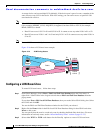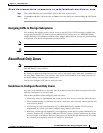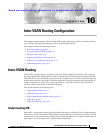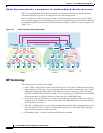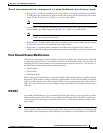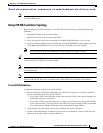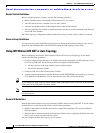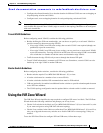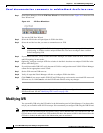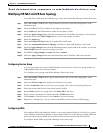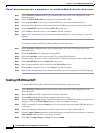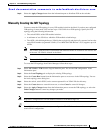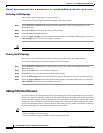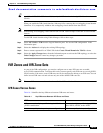
Send documentation comments to mdsfeedback-doc@cisco.com.
16-6
Cisco MDS 9000 Family Fabric Manager Configuration Guide
OL-6965-03, Cisco MDS SAN-OS Release 2.x
Chapter 16 Inter-VSAN Routing Configuration
Inter-VSAN Routing
Border Switch Guidelines
Before configuring border switches, consider the following guidelines:
• Border switches require Cisco MDS SAN-OS Release 2.1(1a) or later.
• A border switch must be a member of two or more VSANs.
• A border switch that facilities IVR communications must be IVR enabled.
• IVR can (optionally) be enabled on additional border switches to provide redundant paths between
active IVR zone members.
The VSAN topology configuration updates automatically when a border switch is added or removed.
Service Group Guidelines
If you use service groups with IVR auto topology, you should enable IVR and configure your service
group first, then distribute them with CFS before setting the IVR topology in auto mode.
Using IVR Without IVR NAT or Auto Topology
Before configuring an IVR SAN fabric without IVR in NAT mode or IVR topology in auto mode,
consider the following guidelines:
• Configure unique domain IDs across all VSANs and switches participating in IVR operations if you
are not using IVR NAT. The following switches participate in IVR operations:
–
All edge switches in the edge VSANs (source and destination)
–
All switches in transit VSANs
• Configure IVR only in the relevant border switches.
• Acquire a mandatory Enterprise License Package or SAN-EXTENSION license package if you have
Cisco MDS SAN-OS Release2.1(1a) or later and one active IPS card for this feature.
Tip If you change any FSPF link cost, ensure that the FSPF path distance (that is, the sum of the link costs
on the path) of any IVR path is less than 30,000.
Note IVR-enabled VSANs can be configured when the interop mode is enabled (any interop mode) or disabled
(no interop mode).
Domain ID Guidelines
Domain IDs must be unique across inter-connected VSANs when not using IVR NAT. To ensure unique
domain IDs across inter-connected VSANs, consider these guidelines:
• Minimize the number of switches that require a domain ID assignment. This ensures minimum
traffic disruption.
• Minimize the coordination between interconnected VSANs when configuring the SAN for the first
time as well as when you add each new switch.
You can configure domain IDs using one of two options:



